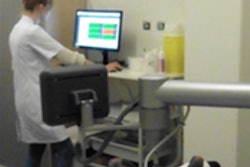
Zoom out. That's the advice of Dutch radiologists who found some tumors missed by breast screening radiologists can be detected from 1.5 m away. They recommend radiologists take a "distant view" before closely evaluating a mammogram in detail.
In the Netherlands, screening radiologists must register with the national quality registry, pass a screening training, read a minimum number of 3,000 screening mammograms a year, participate in continuing medical education, and attend locally organized quality assurance evaluation sessions.
During one such quality assurance evaluation session, it was noticed that individual screening radiologists missed tumors that could seemingly be detected from farther away, an idea long championed by Dr. Ineke Schreutelkamp from Bevolkingsonderzoek Zuid, Maastricht-Airport, the Netherlands. While hospital staff were aware of her idea for many years, the notion had never been quantitatively studied -- until details of their recent study were presented at ECR 2016.
The setup
The researchers compiled a test set of 84 digital screening mammograms. Screening mammograms were performed in two views per breast: craniocaudal (CC) and mediolateral-oblique (MLO). A senior screening radiologist identified 28 screening mammograms with a pathologically proven malignant tumor missed by an individual screening radiologist. In the senior radiologist's opinion, all of the tumors could have been detected from a distance.
The 28 screening mammograms were mixed with 56 normal screening mammograms. For all normal mammograms, a subsequent negative screening exam was available. The test set was independently evaluated by another senior screening radiologist and a radiology resident without prior training in screening mammography.
The screening mammograms were read at a 1.5-m distance from the screen display. Both readers independently completed the test set at their own speed without any time restriction. They were blinded and unaware of the prevalence of pathologically proven malignant tumors in the test set. Primary outcome was whether the reader would recall the woman or not.
 Above: A radiology resident at Zuyderland Medical Center is absorbed by the screen of the diagnostic workstation. Below: The radiologist gets a better overview of the mammogram by moving the chair back. Images courtesy of Dr. Miraude Adriaensen.
Above: A radiology resident at Zuyderland Medical Center is absorbed by the screen of the diagnostic workstation. Below: The radiologist gets a better overview of the mammogram by moving the chair back. Images courtesy of Dr. Miraude Adriaensen.How did they do?
The senior screening radiologist recalled 28 out of 28 women with a pathologically proven tumor and 16 out of 56 women without pathology, resulting in a case sensitivity of 100% and a case specificity of 71%. The radiology resident recalled 25 out of 28 women with a pathologically proven tumor and 10 out of 56 women without pathology, resulting in a case sensitivity of 89% and a case specificity of 82%.
"This study was designed to determine whether tumors missed by individual screening radiologists can be detected from a distance," said Dr. Miraude Adriaensen, PhD, from the radiology department at Zuyderland Medical Center in Heerlen, the Netherlands, who presented the study at ECR 2016. "And the answer is yes. ... Even the radiology resident without prior training in screening mammography recalled 25 out of the 28 women with a pathologically proven tumor."
Limitations
The study does have some limitations, however; namely the use of a test set. It is impossible to represent daily screening practice in a test set, so the researchers had to use an enriched test set in their environment.
"Of course, in daily screening practice, it is more time-consuming to move the chair 1.5 m back and forth for every screening mammogram," she said. "However, our study shows that sometimes it does help to literally move the chair backward."
Having such awareness may help the mindset of screening radiologists and hopefully improve their tumor detection rate, she added.
"When Dr. Schreutelkamp retired from our hospital, our current residents made a movie for her and the message of taking a global distant view was well incorporated," Adriaensen told AuntMinnieEurope.com. "First, a radiologist was shown looking at the screen from a short distance and, in the end, the radiologist was looking to the screen as an astronaut from space."



















